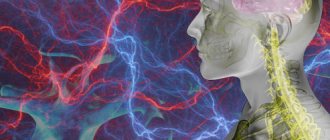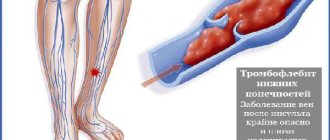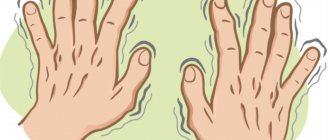Why do my legs and arms go numb? What diseases can lead to these symptoms? Which doctor should I contact? How to diagnose the cause?
Numbness in the arms and legs is a neurological symptom that most often indicates damage, inflammation, or compression of sensory nerves. Often, numbness is accompanied by pain and unpleasant sensations such as tingling and “crawling goosebumps.” Many nerves are mixed, that is, they contain both sensory and motor fibers. In such cases, numbness is combined with a decrease in muscle tone and impaired movement.
There are many reasons for numbness in the limbs. Most often they are associated with pathological processes in peripheral nerves. The larger the nerve, the larger part of the limb loses sensation. In rare cases, the symptom is caused by disorders of the brain and spinal cord.
Numbness from compression of nerves and nerve roots
One of the most common conditions that leads to compression of the nerve roots is intervertebral hernia. Most often it forms in the lumbar spine, as it experiences the heaviest loads. Fortunately, in most cases, if you consult a doctor in a timely manner, intervertebral hernias can be treated without surgery.
Carpal tunnel syndrome leads to numbness, tingling in the hand and other symptoms. In the wrist area there is a tunnel formed by bones and ligaments. It contains a nerve that, under certain conditions, can be compressed.
In the area of the shoulder girdle and collarbone is the brachial nerve plexus - all the main nerves innervating the arm depart from it. During injuries (most often road accidents), these nerves are stretched and compressed, resulting in numbness and, in severe cases, paralysis of the arm.
With spondylolisthesis, the upper vertebra “slips” a little from the lower one, this leads to compression of the spinal cord and nerve roots, and sensitivity disorders.
Numb hands
If part of an arm or leg is numb, the cause may be a herniated disc, thoracic outlet syndrome, a tumor that presses on the nerve plexus, brachial plexitis, carpal tunnel syndrome, and common peroneal nerve compression syndrome.
With carpal tunnel syndrome, the wrist or hand (thumb, index, middle, and part of the ring finger) becomes numb or painful. This usually happens to those who work a lot at the computer, knit, drive a car for a long time, etc. Why do my arms and legs go numb? The median nerve, which passes to the hand through a “tunnel” (carpal tunnel) of three bones and ligaments, is pinched. Compression of the median nerve below the elbow and above the wrist causes numbness not only in this area, but also around the hand at the base of the thumb. This happens if, for example, the tendon, which is located next to the median nerve, is irritated and therefore enlarged.
Swelling due to injury, fluid retention, pregnancy, and rheumatoid arthritis can cause carpal tunnel syndrome. But the condition usually develops in those whose carpal tunnel is initially narrower than most people's. If there is a need for pain relief, conventional non-steroidal anti-inflammatory drugs (ibuprofen, naproxen) can be used. It is usually recommended to reduce the movements that provoke symptoms and apply a splint for a while. If the pain and/or numbness does not go away, surgery may be required.
With brachial plexitis, not only the shoulder, as the name implies, can become numb, but also the entire arm and hand. The mechanism of this disease is as follows: the brachial plexus, from which the nerves go to both arms, is compressed or damaged. Brachial plexitis can be a consequence of a lung tumor, radiation therapy, or birth trauma. Numbness is not its only symptom; often such patients have severe shoulder pain, the pain is replaced by weakness. Symptoms usually resolve with anti-inflammatory treatment with corticosteroids.
Tingling and numbness in the leg
In common peroneal nerve compression syndrome, numbness or tingling is felt in the top of the foot or inner leg. The peroneal nerve is a branch of the sciatic nerve and supplies the toes, feet, and legs. A knee injury, a broken fibula, a tight shin cast, and even frequent crossing of the legs can lead to this syndrome. Treatment for numbness involves eliminating the cause. But sometimes a corticosteroid injection may be needed to reduce the swelling, and in some cases surgery is performed.
Numbness of fingers
The cause of thoracic outlet syndrome is that the blood vessels and nerves between the collarbone and the first rib are compressed. As a result, the shoulder and neck hurt, and the fingers feel numb. This can happen due to a car accident, sports injury, or during pregnancy. The syndrome, fortunately, occurs rarely - in 1 person out of a million. Usually, taking painkillers is enough to control symptoms.
Severe calcium deficiency may cause numbness in the toes and hands, abnormal heart rhythm, and seizures. This is a fairly rare condition, the cause of which must be determined by a doctor.
Due to edema, tumors, injuries, etc. Other nerves in the arm may also be compressed, resulting in specific symptoms:
- Compression of the ulnar nerve in the wrist area leads to numbness of the little finger, part of the ring finger and part of the hand on the little finger side;
- Compression of the ulnar nerve in the elbow area leads to both these symptoms and numbness in the elbow area;
- Compression of the radial nerve in the forearm can cause numbness in the thumb and index finger.
Vascular disorders
One of the complications of diabetes is diabetic neuropathy, damage to sensory, motor and autonomic nerves as a result of impaired blood flow in small vessels. One possible symptom is numbness in the limbs.
There is a large group of diseases - vasculitis. Autoimmune inflammation develops in the vessel wall, it thickens, becomes weakened, and scarring occurs. In the lumen of the vessel, areas of narrowing appear in which blood flow is disrupted. Various organs, including nerves, can suffer from this.
With one of the systemic connective tissue diseases - Raynaud's disease - a spasm of the small vessels that supply blood to the fingers and toes occurs. In response to cooling or stress, a feeling of coldness and numbness occurs in the fingers.
Diseases of the brain and spinal cord
One of the most common causes of numbness in different parts of the body associated with brain damage is a stroke, as well as a transient ischemic attack, which is popularly called a “mini-stroke”. Severe injuries to the brain and spinal cord can lead to sensory impairment.
Less common are such lesions of the central nervous system as an aneurysm (a pathologically enlarged, weakened area) of a cerebral vessel, arteriovenous malformation (incorrect communication between an artery and a vein, when blood is discharged directly, bypassing the network of capillaries), tumors of the brain and spinal cord, paraneoplastic syndrome ( damage to the nervous system caused by a tumor that is located outside the brain).
The article lists only the main common causes of numbness in the arms and legs. There are others. In order to get an accurate diagnosis and begin proper effective treatment, you need to visit a doctor.
Causes of numbness in limbs
Numbness of the limbs can occur due to pathological processes in the peripheral nerves, in the presence of disorders in the spinal cord and brain. Numbness can occur with:
- Vasculitis or stroke, they worsen, block the blood supply to the nerves.
- Injury or neuropathy of the sensory pathway.
- Compression on any part of the route.
- Nerve infections (leprosy, HIV, Lyme disease).
- Inflammation or destruction of the outer layer of nerves.
- Metabolic disorders (diabetes, heavy metal or toxin poisoning).
It is also worth paying attention to excessive pressure on the nerves, repeated for a long time, for example, crossed legs when sitting. Narrowing of the lumen in the spinal canal, osteoarthritis, damage to the intervertebral discs. Pressure near the spinal cord due to a tumor, hematoma, or damage to the spinal cord due to trauma. Only a neurologist can more accurately determine the cause of numbness. The following are common causes of numbness in body parts:
- The head area and areas of the face may become numb due to: fungal infection, glossopharyngeal neuralgia, herpes zoster, trigeminal neuralgia, stroke, migraine and osteochondrosis.
- The torso area becomes numb in the presence of: suspicion of radiculitis, intercostal neuralgia, coronary heart disease, pathologies of the genitourinary system, kyphosis.
- Hands may go numb due to: diseases of the spine, diabetes and intoxication, disturbances in the functioning of the heart.
- Fingers may go numb due to: a hernia in the spine, hand injury, heart disease, carpal tunnel syndrome.
- Legs and toes go numb with: the presence of hernias, cauda equina syndrome, osteochondrosis and pinched sciatic nerve. Various types of varicose veins, atherosclerosis and arthritis may be present.
Who should I contact?
A neurologist is involved in the diagnosis and treatment of neurological disorders, such as sensory loss and numbness in the extremities. In order to correctly assume what was the possible cause and choose the right direction of the diagnostic search, the neurologist must examine the patient, find out in which parts of the body numbness occurs (only in the fingers, in the hands or feet, in the entire arm or leg, in one limb , or right and left symmetrically), are there any other neurological symptoms or concomitant diseases.
Depending on the results of the examination, the neurologist may refer you to other specialists:
- For vasculitis, Raynaud's disease - see a rheumatologist.
- For cardiovascular pathologies, see a cardiologist.
- For diabetes mellitus, see an endocrinologist.
- In case of tumors or injuries, see a neurosurgeon.
- For infectious diseases - see an infectious disease specialist.
- In case of poisoning with harmful substances at work, contact an occupational pathologist.
Symptoms
Numbness usually occurs due to poor circulation in a particular area or nerve damage. Sensory disturbances (numbness) can also be the result of infection, inflammation, trauma and other pathological processes. In most cases, numbness is due to non-life-threatening illnesses, but it can also be a sign of a stroke or tumor.
Numbness in the extremities is often associated with pain or may be accompanied by other sensory disturbances such as burning or tingling. Strokes also cause motor and speech disorders. Depending on the cause, numbness may disappear quickly, for example, numbness in the arm , which occurs when a person sleeps with their head on their arm, disappears after a few movements of the arm. Chronic numbness in a leg or arm over a long period of time usually indicates some level of nerve damage, such as due to diabetes or multiple sclerosis. Chronic numbness in the fingers may be due to a pinched nerve, as is the case with carpal tunnel syndrome. In any case, numbness that lasts more than a few minutes merits attention and medical attention. And if a person experiences numbness in the groin area and impaired bladder and bowel function, or there are signs of paralysis, confusion, speech impairment, then in such cases it is necessary to seek emergency medical help.
Symptoms that may accompany numbness:
- Anxiety
- Burning feeling
- Frequent urination
- Increased numbness or tingling while walking
- Itching
- Lower back pain
- Muscle spasms
- Pain in the neck
- Pain in other parts of the body
- Pins and needles sensation
- Rash
- Increased sensitivity to touch
A number of symptoms accompanying numbness may be a sign of serious conditions and this must be taken into account by the doctor, since emergency medical care and necessary medical procedures are often required.
These are the following symptoms:
- Lethargy or momentary loss of consciousness
- Labored breathing
- Difficulty walking
- Dizziness
- Loss of control over voluntary urination or bowel movements
- Visual impairment
- Numbness in the head, neck, back
- Paralysis
- Speech disorders (dysarthria)
- Weakness
Examination for numbness of extremities
- Depending on the suspected cause of numbness in the limbs, the doctor may prescribe different types of diagnostics. X-rays help diagnose diseases associated with disorders of the skull and spine, such as intervertebral hernia. If there is a suspicion of vascular pathology, angiography is performed - an X-ray examination with the introduction of a contrast solution into the vessels.
- If necessary, you may be prescribed other imaging methods: ultrasound, CT, MRI.
- In order to check in which nerves the conduction of impulses is impaired, electroneuromyography is used - a study using special electrodes.
- Sometimes they resort to the method of evoked potentials. Special sensors are placed on the patient's head to record brain activity. The affected nerve is stimulated through the skin using electrical impulses and the brain is observed to respond to the stimulation.
Since dozens of different reasons can lead to numbness in the arms and legs, the diagnostic program must be individual for each patient. In some pathologies, if left untreated for a long time, even more serious, irreversible neurological disorders may occur. Visit a neurologist, make an appointment by phone: +7 (495) 120-08-07










